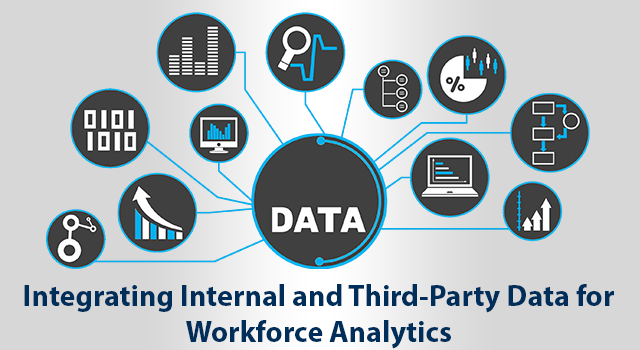Importance of Integrating Internal and Third-Party Data for Workforce Analytics
- January 6, 2023
- Posted by: Admin
- Category: Uncategorized

Most medium- to large-sized HR departments utilize a Human Resources Information System (HRIS) to organize and analyze workforce management. However, relevant data is not always contained within the HRIS. Besides the HRIS, important workforce data exists in multiple silos and unstructured formats via documents such as spreadsheets and text documents, and even non-HR systems such as a CRM.
For a workforce analytics solution to be successful, it must integrate, automate and operationalize the data needed from multiple HR and non-HR sources. Beyond this basic level, there are also many external data sets and sources that can enrich workforce insights.
These sources of information include social media, as well as socio-economic, geo-demographic data. Understanding HR trends along with external data, social media listening and new sources of data can transform your workforce management within an HRIS.
HR Trends
Over the past few years, generating insights from workforce and HR data to make assessments and predictions to improve HR management has skyrocketed. Both the volume and quality of such information has given rise to new opportunities in HR Analytics.
Understanding HR Analytics, otherwise known as People Analytics, is a crucial step toward success for the modern human resources team, as every aspect of HR promises to be affected by evolving data requirements.
According to a 2018 article that appeared on HR Technologist, there are five pinnacles of HR management that will be most notably transformed by predictive analytics. These five essential categories are:
- Recruitment.
- Performance.
- Upskilling.
- Employee engagement.
- Retention.
Organizations now possess the ability to access data and practice techniques to make predictions that improve every area of interaction with employees. For deeper insights, organizations need to utilize all relevant data both within and outside the human resource information system.
Structuring this necessary HR data and organizing it into the six basic components of an HRIS will help to centralize HR data. However, most organizations have a wealth of decentralized data that lies outside the structured format of these six components. Common sources of such unstructured data that must be integrated into the HRIS include:
- Structured spreadsheet data
- Survey system data
- PDF and document management system files
- Word documents
Of course, organizations will have various differing needs and functionality from an HRIS, but these six components are essential to any workforce management process. The centralized database, typically structured as a relational database model system (RDMS), is the backbone of providing structure and order to any set of information.
A database system includes the ability to query against structured data and retrieve individual rows that all pertain to the necessary element for workforce analytics. In other words, all other functions such as time management, payroll, benefits, user interface and recruitment data are all stored as records in the centralized database that relates the entire HRIS together.
External data
External third-party data is quickly being recognized for its ability to provide deeper insights into workforce analytics. These types of data take many forms, such as socioeconomic and geo-demographic data, which offer important inputs for HR analytics.
This data will help to better understand compensation strategies, such as the concept of Purchasing Power Parity regarding the value of salaries to employees. Often, this information is readily available through research organizations and institutions such as the World Bank or OECD.
Such data provides better insights into the demand for jobs and skills relative to competitors, and could play a major factor for an organization that is considering geographic expansion. Integrating external HR data also regularly occurs when companies acquired via mergers have data and HRIS systems that are unlikely to be fully integrated with the parent company’s HRIS.
The Innovation Enterprise outlines several use cases for how companies should integrate their external data. There is a tendency to store external data in separate silos, where drawing conclusions becomes a difficult task. Business intelligence analysts at Indeed.com were able to detect strong patterns of job seekers outside of Great Britain coinciding with Brexit by referencing against economic data provided by another research arm of their company.
Social media listening
One unique case for HR teams to take advantage of external data is by practicing social media listening via sites such as Glassdoor and LinkedIn. Social media listening or social media monitoring is the process of assessing personal sentiments and what is being said about a specific company or brand across digital platforms.
For workforce management, monitoring social networking data can be incredibly useful to predict patterns of external job-seeking behavior and retention risk.
Engagement and retention
Organizations can begin to assess employee attrition and the propensity to accept an offer based on the activity on such sites and job boards. When there is an exodus of employees who leave your company, analyzing data will help find patterns about what is driving retention, including what factors are driving people to seek other opportunities
These insights will be valuable in establishing organizational improvements to implement and helping your company identify and attract people with top skills while also increasing the engagement levels of current employees. Social media listening for HR teams can be used for more than just understanding retention statistics and why employees are not fully engaged with your company.
Utilizing social media can be an excellent tool for your recruitment and hiring strategy, as potential applicants tend to scour online data and research as much as they can about your company, from management styles to employee benefits and salary information to career development.
Hiring and recruiting
Many companies now find themselves at a disadvantage when it comes to hiring in the digital age because the first point of contact is no longer directly in the hands of the company. Rather than shy away or ignore the prevailing sentiments present across social media, a smart approach to workforce management is to mine and scrape these social media platforms for as much data as possible.
This data can generate insights that can identify, address and resolve glaring issues or impediments when it comes to recruitment. Accessing, structuring and storing social media data efficiently is another challenge that requires data integration foresight.
LinkedIn offers a Rest API to developers to directly access and interact with their user data, storing files in JSON format, which is standard for many other APIs. Using data mining techniques and sentiment analysis is a strong starting point for jumping into social media listening for those with technical expertise.
New sources of data
With many new sources of data being now available, many large organizations are undertaking major projects to analyze and integrate data into their decision-making, and these projects are not without their challenges.
The challenge of data accuracy impacts HR Analytics to a great degree. Missing, duplicate and invalid data are obstacles in every HRIS, and will likely impact your organization in some manner. Therefore, having the personnel and processes in place that can manage data accuracy and efficiency is an integral part of workforce management.
From a recruitment perspective, data harvested from voice communications, personal interactions, video interviews, employee feedback and performance can all be used to identify management challenges, send coaching tips to different leaders, and identify key knowledge management resources.
However, with new sources of data come new data integration challenges. Many of these sources have different data types and structures that do not conform to a traditional relational database model or are simply difficult to analyze in volume. Modern approaches to integrate and analyze such data sources are needed. “NoSQL” databases such as Hadoop provide a current solution to organize unstructured data formats, representing the newest wave of data management.
The path forward: Using employee training for integrating all types
One critical component of workforce management is internal skill development, and a recent study found that 59 percent of employees did not know which skills would help make them successful in the future. In an evolving workplace, organizations and individuals alike may struggle with adapting to the evolving tools, practices and abilities that will achieve success.
One way that companies are combating this challenge is by rolling out internal employee development and training platforms. Often, these learning platforms offer several hours of specially designed content in the form of video and assessments for employees to study and progress.
Integrating these content learning platforms depends on many factors, such as whether the platform is externally or internally developed. Proper integration could be as simple as adding a link to the company’s intranet or HR-specific page. However, an HRIS or skill development platform must also support new data types and media relating to each course and individual assignments.
A more intentionally designed platform might offer the ability to directly connect to an employee portal that tracks all aspects of career development, including performance reviews and development goals. Not all HRIS products can support this type of integration, so consider whether a skill-learning platform would be a major benefit to your employee engagement and how to best support such a platform.
Conclusion
To summarize, new sources of data at the individual level is being generated at an unprecedented volume. Organizations that invest in integrating, storing and analyzing such data at every level of operations, including HR and workforce analytics, are most likely to reap the benefits.
Bonnya Mukherjee
Financial Analyst, Pegasus Knowledge Solutions


